NORTH SAILS BLOG
Alle
Events
Guides
News
People
Podcast
Sustainability
Tech & Innovation
Travel & Adventure
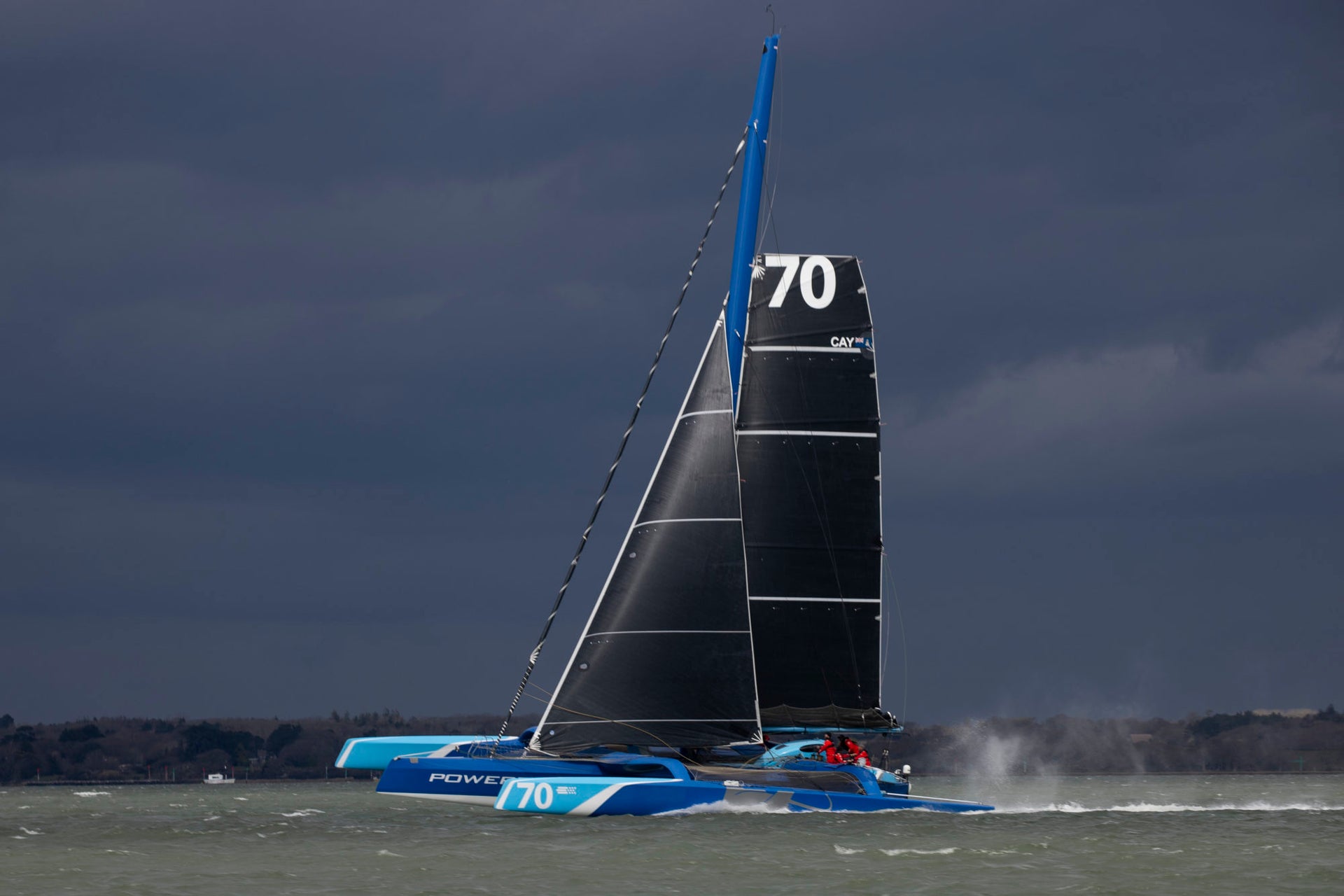
NEW FASTNET RECORD
NEW FASTNET RECORD
MOD70 PowerPlay Sets New Fastest Time
📸 Lloyd Images
The MOD70 Trimaran PowerPlay, led by Peter Cunningham and skippered by Ned Collier Wakefield, has set a new Fastnet record.
The team completed the original Fastnet course of 595 nautical miles in a new world Fastnet record of 25hrs 04mins 18secs (subject to ratification by the World Sailing Speed Record Council), shaving almost 3 hours off the record set by Maxi Edmond de Rothschild in the 2019 Fastnet.
The boat in its previous incarnation as Concise 10 with many of the same crew also took line honors in the 2017 Fastnet Race. “It was kind of ambitious, but the conditions were right, and the team was ready to go,” commented Peter Cunningham. “The PowerPlay crew was fantastic. Miles (Seddon) did a brilliant job navigating, we had two wonderful drivers in Ned Collier Wakefield, who set up the boat and runs the program, and the fastest sailor on Earth, Paul Larsen, who drove in some incredibly bad conditions.”
Shortly after midday on Monday 05 April, in a bitterly cold strong northerly wind, PowerPlay started their Fastnet record attempt on the Squadron Line at Cowes. PowerPlay made short work of racing to Lands’ End and powered across the Celtic Sea at speeds in excess of 30 knots. PowerPlay rounded the famous Fastnet Lighthouse and raced through the night. On Tuesday 06 April, at 13:42 and 19 seconds BST, PowerPlay reached the Plymouth Breakwater, where the team celebrated their amazing run of 25 hours, 4 minutes, and 18 seconds.
Republished from PowerPlay Racing
READ MORE
READ MORE
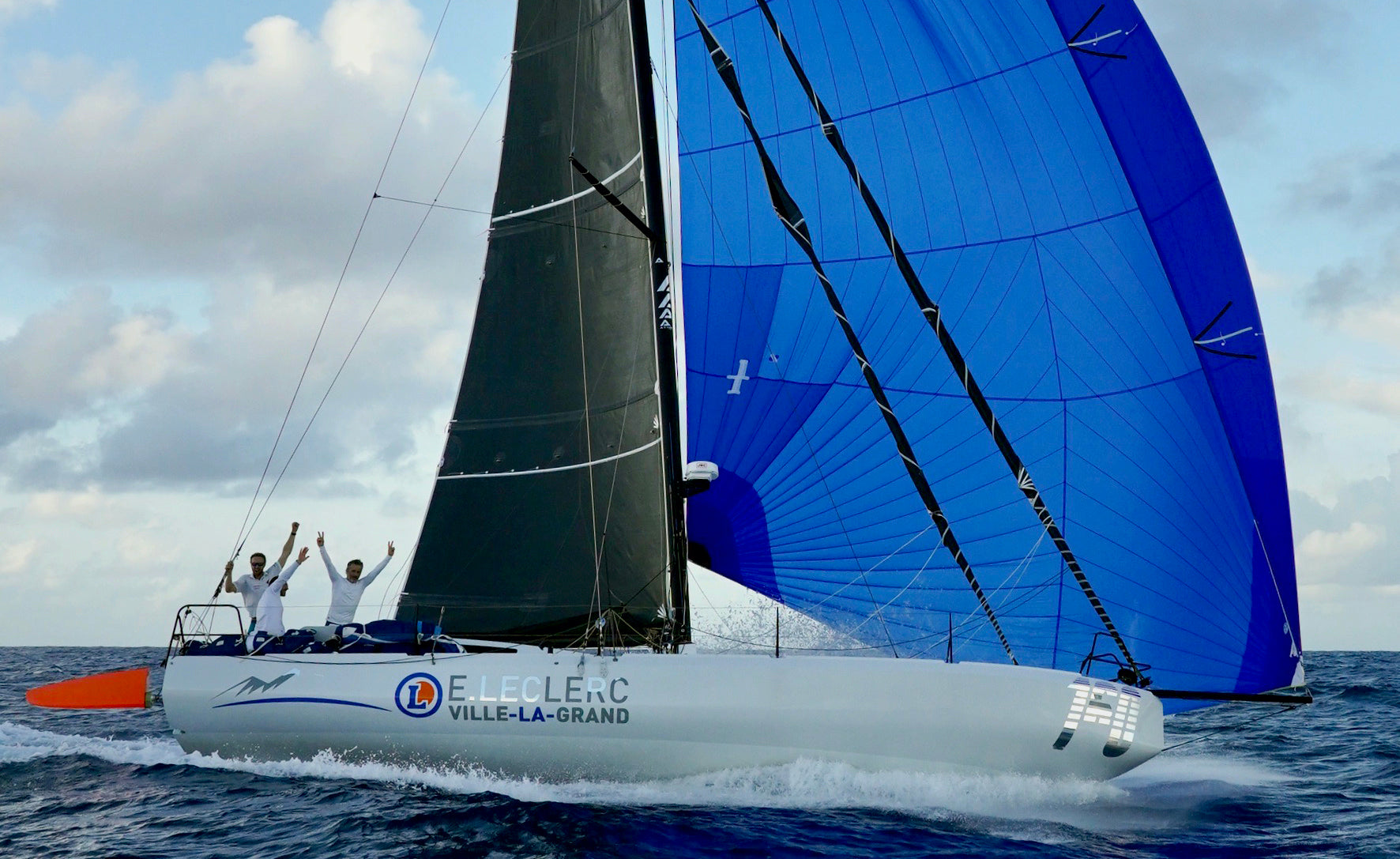
#NSVICTORYLIST: RORC TRANSATLANTIC
#NSVICTORYLIST: RORC TRANSATLANTIC
Powerhouse Trio on Class40 Palanad 3 Wins Overall
📸 Ed Gifford
Olivier Magre and son Antoine launched their brand-new Class40 Palanad 3 in June of 2020 with an ambitious plan: compete in the RORC Transatlantic and the Caribbean 600. Combined with a full season of Class40 racing in 2021, those two events would provide the miles needed to qualify for Olivier’s ultimate goal, the 2022 Route du Rhum.
The Class40 is designed to sail shorthanded, and Olivier finds three to be the lucky number. First, he signed on Corentin Douguet, a well-known Figaro racer, brilliant with weather and strategy. Next, he asked Luke Berry, a young, strong sailor who usually races on his own Class40 and would be the perfect fit and go up the mast when needed. Youth strength plus experience: it turned out to be a winning combination.
“Everyone can do every job, and with the talent we had onboard, we were able to make all the right moves at the right time.”
The RORC Transat was a great chance to test the boat’s downwind sailing potential“, said Olivier. “We had strong competition with Redman, and it was a lot of fun to get to know the boat more and see how hard we could push her.”
Class40s have rounded bows (like Scows), and the design is built for pure speed. Antoine explains, “With all weight focused aft and an eight-degree mast rake, it looks like a windsurfer.” Boat speed is comparable to an IMOCA, Olivier adds. “We hit 27 knots during the Transat. Even on our trip to the starting line in Lanzarote, we saw 28-29 knots. Impressive! Our average speed over ten days was 14 knots. It feels effortless to sail this boat fast, nonstop. It’s a lot of fun!”
Check out what the race was like onboard. 📹 Courtesy of Luke Berry.
Olivier and Antoine both credit the support they received from North Sails experts to get the new boat up to speed. Palanad 3 is equipped with a 3Di RAW 760 main, J1, and J2. In addition, they have an A2, A5, A6, and a FR0.
North Sail expert Alan Pennaneach joined him for the 2020 Dhream Cup and was involved in every step, including onboard training, testing systems, and fine-tuning sails and trim. “We’ve been delighted with our experience and our partnership throughout our program development,” Antoine said. “The feedback is helpful and constructive, the customer service is great, and the sails have not disappointed. It’s been a very positive experience.” Laurent Tilleau, who recently retired, was also a significant part of the Magre’s North Sails experience as they raced together for several years on previous boats.
“The feedback is helpful and constructive, the customer service is great, and the sails have not disappointed. It’s been a very positive experience.”
Olivier’s son Antoine first sailed with 3Di in 2013, and he was impressed, so a new suit of sails from North for the new boat was a must. “The stiffness provides a better feel on the helm, and of course, more durability over time. Our first suit of 3Di lasted 3-4 seasons, and we pushed them hard. With a proper service plan in the off-season, too, our sails were in perfect condition every time we needed them.”
3Di is also lighter and easier to handle than traditional sail materials, both on and off the boat. The weight difference was even more apparent when helping another Class40 with their sails. “We were shocked about how light ours were, after picking theirs up.”
📸 Pierre Bouras
Both father and son enjoy the Class40’s camaraderie. “Before events and after training sessions, we discuss sail selection and design, sail shapes, rig setups– there is a ton of exchange and collaboration, which is why the Class40 is such a great class to be part of.”
Palanad 3 had three crew members on board for the RORC Transatlantic. After the first six hours, they took watches of two hours on, two hours off. For sail transitions or maneuvers, it was all hands on deck. “The Class40 is built for racing,” said Olivier. “The boat designer didn’t care about comfort, so cooking is still a work in progress for us.” With a jet boil for hot water and no water maker, the only hot meal options were freeze-dried or boil-in-the-bag food. “We definitely don’t go sailing for the food,” said Olivier, “but we also enjoyed cold salads with rice and tuna, especially good in the warm weather.”
He said there were two critical things to Palanad‘s Transat victory: the start and avoiding the wind shadows under the Canary Islands, and avoiding sargassum seaweed whenever possible. The tradewinds were stronger farther south, but that’s where the seaweed patches were much thicker, so they planned out their route carefully. “Every 20 minutes, we had to do a weed check,” said Olivier. “The best method we found was to broach the boat intentionally to knock it all off.” For future races, they plan to add a kelp cutter.
All around, the team is composed of seasoned talent. “Everyone can do every job, and with the talent we had onboard, we were able to make all the right moves at the right time,” said Olivier.
With over ten new boats launching this year, the Class40 will only get more competitive and more exciting for all involved. Olivier and his crew hope to get as much time in the boat as possible this year in preparation for the 2022 Route du Rhum.
“We had planned to sail the Caribbean 600, but it was canceled,” Antoine explained. “So Palanad 3 is now headed back to Europe.” The team will start training for the Normandy Channel Race in April, followed by scheduled racing, the Rolex Fastnet in August, and then potentially the Transat Jacques Vabre. “The end goal is the Route du Rhum, and I am sure there will be plenty of smaller races in between to continue to improve on the boat,” said Antoine. “We’ll work hard to keep our training going whether events still go on as planned or not. It’s all about sailing the boat fast–and we’ve got some pretty high expectations!”
📸 Antoine Dujoncquoy
READ MORE
READ MORE
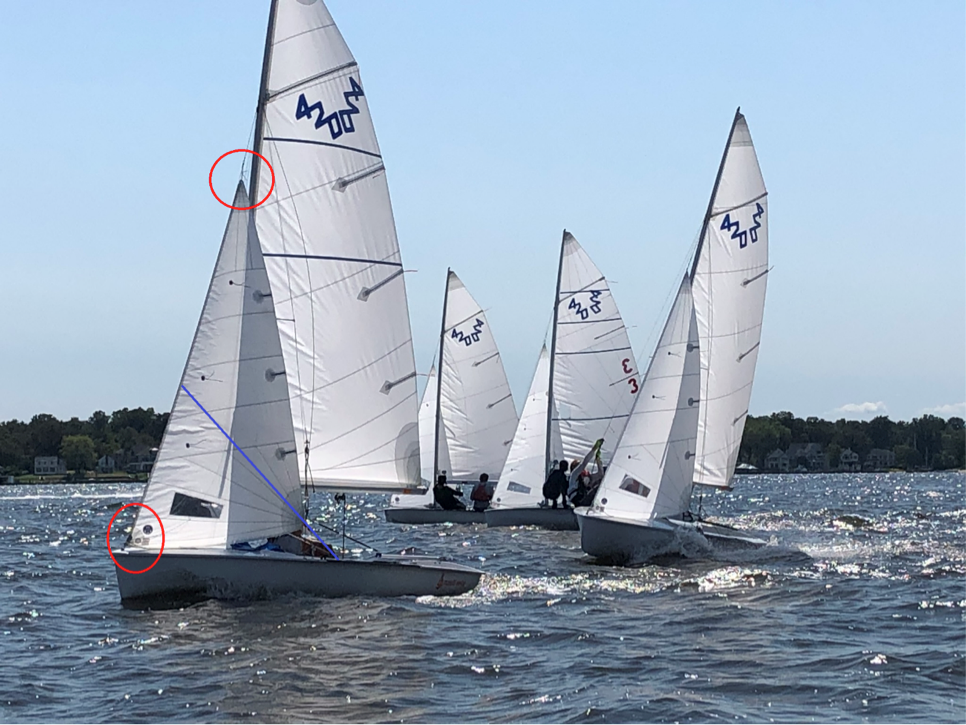
I420: CONTROLLING THE JIB LEECH TENSION
CONTROLLING JIB LEECH TENSION
How to Effectively Finetune Your Fairleads with Fixed Positions
Sailing dinghies are all unique. It is always fun to go from one one-design class to another and check out what makes them different, what controls they have, and in this case, what they might not have available for the crew to use to adjust and tune.
One very important tuning device for jib trim is the fairlead position. Fairlead position defines sheeting angle for the jib, and many classes of course have adjustable fairleads; that is, the position can be moved fore and aft (or in some cases up and down, and in and out). When it gets windy, it’s often nice to be able to open the leech of the jib a little bit, and this can be achieved by moving the fairlead position aft. Conversely, moving it forward can create a more powerful shape.
The 420 was designed, for better or worse, without adjustable fairleads; it is, as they say, where it is. How do you effectively move the fairlead fore and aft in a boat with fixed fairlead positions? The answer on the i420 is jib height. To achieve this, i420 sailors can raise and/or lower the height of the jib on the luff wire to achieve proper leech tension on the jib for given conditions and mast rake.
You may notice boats in-between races that are capsized on their coach boat; often this is done to change jib height to match expected conditions for the next race. The peak rope fixed (and adjustable) at the head of the jib controls jib height. The boat also has an adjustable jib tack control to accommodate changes at the peak. Normally the jib should be fixed by having a proper deck sweeping effect. However, for the i420 class it is important to know the height should be adjusted to provide the optimum jib lead angle. Since, as we said, the sheeting point is fixed, you should adjust the peak rope to move the jib clew up or down to achieve the desired sheeting angle.
In short, lower the jib down a bit to open the leech and ease power when the winds are up; in light winds, raise the jib for more power and jib leech return. It is also imperative to remember that mast rake also has a significant effect on jib leech tension. Raking back effectively opens the jib leech, and conversely, raking forward closes it. Don’t forget this when you tune the boat.
Adding jib height to your tuning regimen can make a performance difference. Experiment, find the right balance, mark your settings, and go faster!
For more information and questions on how to match your North i420 sails perfectly, please contact North Sails clas expert Tom Sitzmann.
2020 Miami One Design Development Program
READ MORE
READ MORE
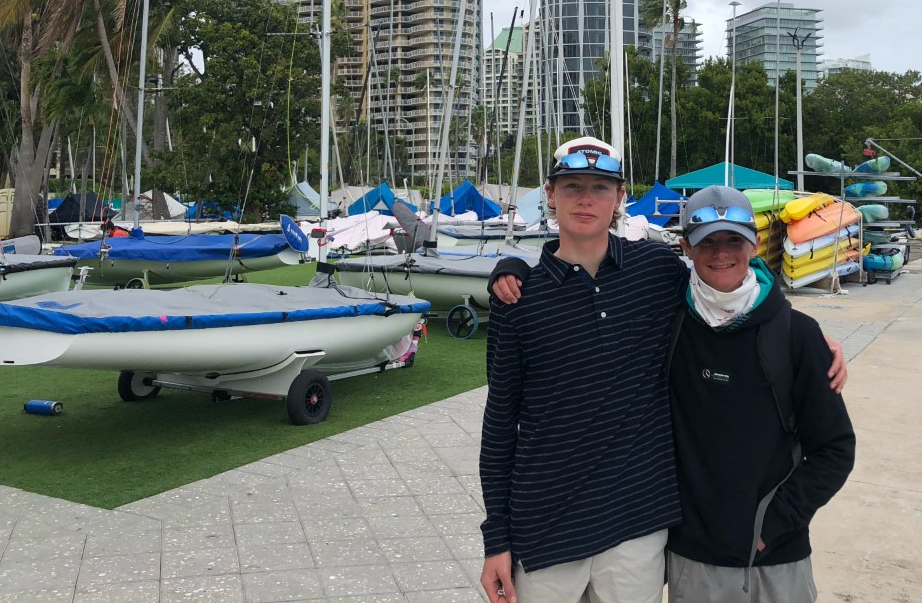
2020 INTERNATIONAL 420 US NATIONALS
2020 INTERNATIONAL 420 US NATIONALS
Congratulations Tommy Sitzmann & Luke Woodworth
The i420 Class doesn’t wait long to crown a National Champion! After a grueling 4-day regatta, with some moderate winds at the beginning and then 3 days of more (and more) wind, congratulations to the 2020 i420 National Championship team of Tommy Sitzmann/Luke Woodworth. According to their parents, these two student-athletes have worked hard, combining top-level sail training along with school and other sports.
Team Outfit Sailing, led by Miami-based coach Lior Lavie, swept the podium, taking the top 3 finish positions. North Sails powered the top three finishers, and the sails worked incredibly well in a varied conditions from marginal trapping, to full-on heavy air.
We continue to study i420 boat sail design and tuning, and we’d love to help you go faster. Please don’t hesitate to contact us with questions!
READ MORE
READ MORE
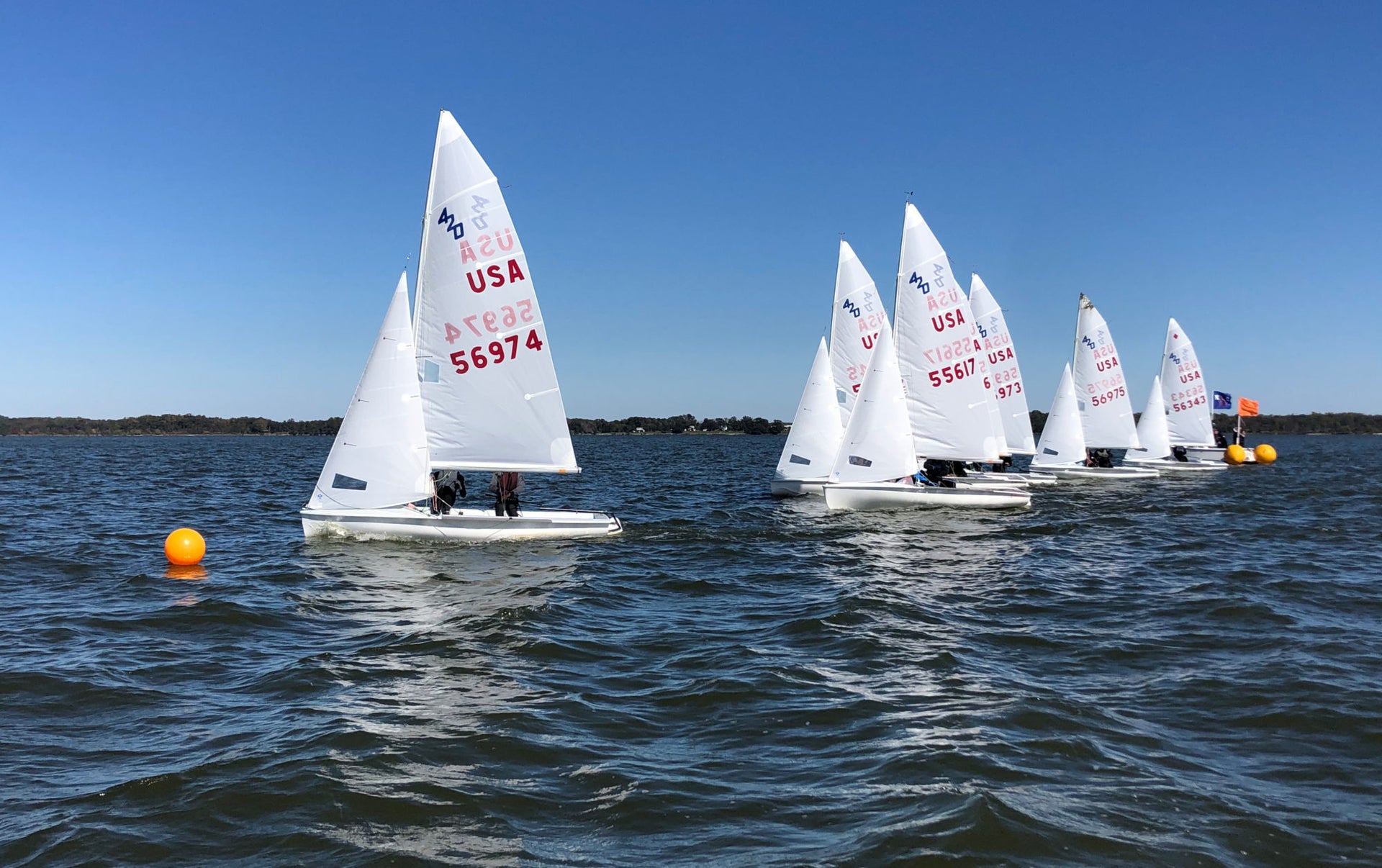
I-420 MID-ATLANTIC CHAMPIONSHIP
NORTH SAILS PODIUM SWEEP AT THE INAUGURAL I-420 MID-ATLANTICS
Congratulations Tommy Sitzmann & Luke Woodworth
The very first International-420 Mid-Atlantic Championship was held on 17-18 October at a new, community sailing venue called The Chesapeake Experience which lies E/NE of Baltimore on the Gunpowder River; a fantastic sailing spot!
Day One, Saturday 17th October – Constant Gear Shifting
The fleet had to wait a bit, but the forecasted northerly came in around 11:30, and four races were run in very light conditions as well as full trapeze sailing. The key to success was constant gear shifting. Unlike an ocean venue, where many i420 regattas are sailed, this inland location threw constant wind shifts and breeze-strength changes at the sailors. Teams that quickly shifted their sail and weight trim were faster as this responsiveness allowed them to link puffs and stay in the phase for longer.
Day Two, Sunday 18th October – Patience, Patience
The Race Committee actively sought wind, moving the racecourse from one part of the river to another to allow two more races to be completed. These races tested the patience of every team, and the young duo of Freddie Parkin and Thomas Whidden (name sound familiar?), outperformed the fleet winning both races. This moved them up to third overall in the final results. Great fun was had by all, and an i420 training fleet is now born at this venue!
Congratulations to Tommy Sitzmann and Luke Woodworth for winning the very first i420 Mid-Atlantic Championship, and Cordelia Burn and Sarah Moeder for their close second-place finish. Boats powered by North Sails dominated this event, finishing 1,2,3,4,5. Most teams used the M-9 mainsail and the J-12 jib, and there were both S-1 and S-5 spinnakers doing very well downwind.
Keen to know more? Contact North Sails expert Tom Sitzmann for a full discussion and we look forward to seeing you next year!
READ MORE
READ MORE
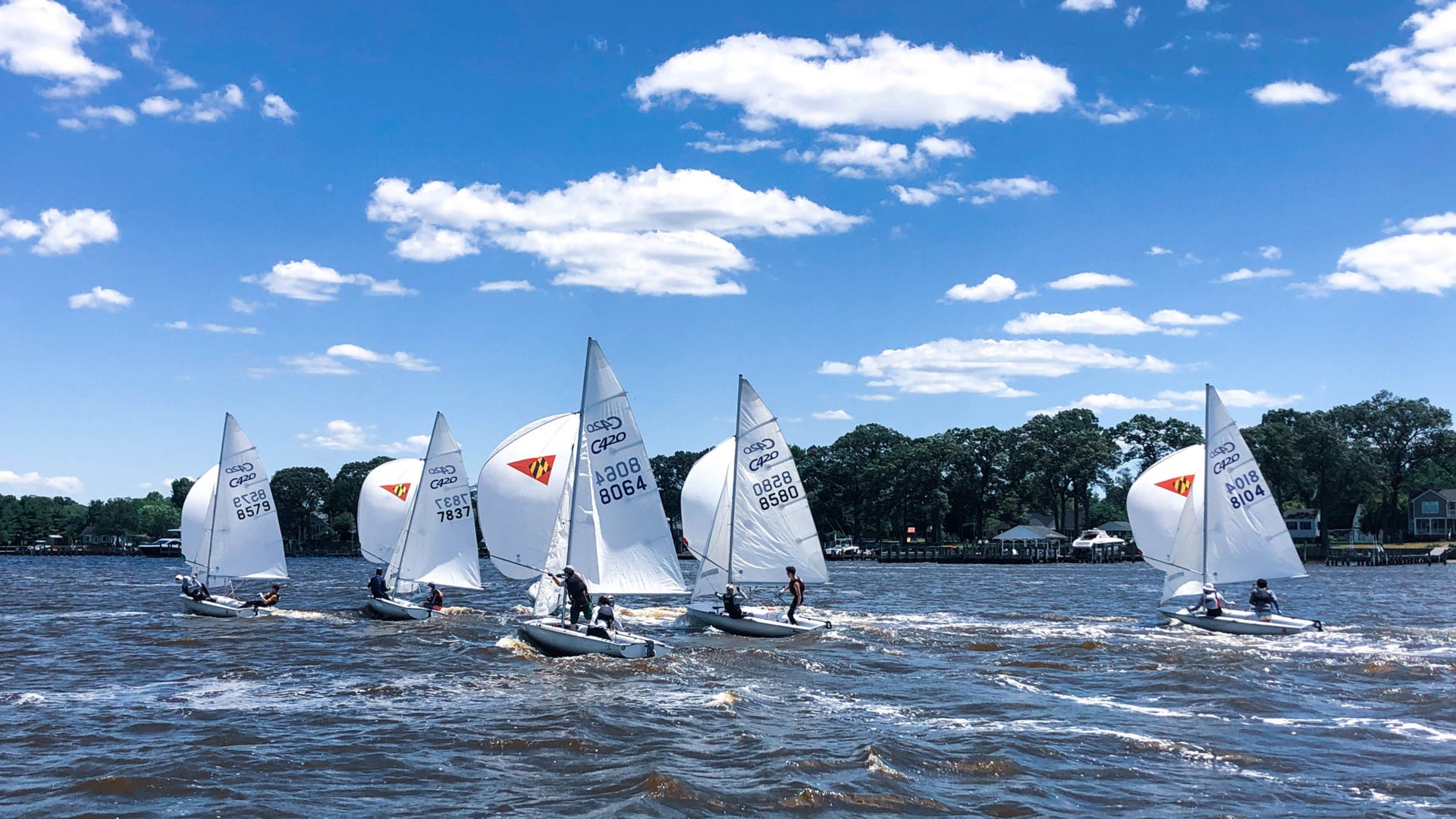
SAIL1DESIGN + NORTH SAILS C420 & I420 CLINIC
SAIL1DESIGN + NORTH SAILS 420 CLINIC
Sailors Joined S1D and North Experts in Maryland
📸 North Sails
Organized soon after the State of Maryland lifted boating/sailing restrictions and careful to mind all social distancing policies and procedures, the 29-31 May North Sails “C&I” 420 Clinic found some very eager participants, who could not wait to get out on the water and get back to sailing.
Limited to six top local teams, chosen by experience and resume, the clinic featured Coach Lior Lavie, an Olympic-level sailor and a highly experienced and successful coach, and North Sails rep Tom Sitzmann. The Clinic was held at Sail1Design, a private venue on the Magothy River, just north of Annapolis, MD.
📸 North Sails
As many know the 420 class sailboat has, in fact, two separate organizing classes, the International 420, and the Club 420. Coming soon will be a detailed article on these two classes, compared, so stay tuned. For now, and very briefly, here is a quick look:
International 420 Class
• Truly an international class, with fleets around the world
• Tapered spar, high performance foil and sailmaker options. The class maintains strict rules but does allow sailors to buy their own favorite brand of foils and sails.
• Rig tuning includes allowing spreader adjustment
• Minimum hull weight is 176.4 lbs.
• Boat will plane upwind and downwind in moderate wind conditions
• Class organization is very strong; USA class participation is good, attracting many of the most talented youth sailors in the country
• The choice for the US Youth double-handed championship
Club 420 Class
• USA only
• Non-tapered spar, can use only class foils and class sails (North Sails is the sailmaker for the C420 class). Hull must have rail bumper. Rules are designed to promote durability.
• Minimum hull weight is 230lbs.
• Boat will plane downwind, not nearly as much or as often upwind when compared to the i420
• Class organization is very strong, class participation is excellent, often with 60+ boats attending major National-level events.
📸 North Sails
One of the goals of this clinic was to expose sailors, first-hand, to the distinctions between the i420 and the C420. North Sails expert Tom Sitzmann, who is currently working on an all-new NS i420 tuning guide, shared some of the tips and tricks that make the North Sails i420 sails set up as they should be (for more information on North Sails i420 options, contact Tom) While both classes offer incredible opportunities for youth sailors, their tuning, trim, and focus points are distinct, and successful teams know these differences. Ultimately, the difference in each boat’s performance characteristics requires teams to dial in to the boat’s capabilities, and recognize tactics must change with boats that go different speeds.
On the first day, 2 i420’s rigged up along with three C420’s, and teams interested in trying out the i420 were able to do so. Coach Lior had both C and i420’s do the same drills, and it was really neat to see the boats out training together. One sailor commented “The i420 was planing upwind for us, almost right out of a tack; I was amazed at how that boat accelerated and seemed to lift up right away.”
Graeme Woodworth, whose son Luke participated in the clinic and was himself a top youth i420 and All-American collegiate sailor, noted that these two classes, back in the 1990’s, did have some overlap, and that the c420 National champion used to be given a spot at the i420 World Championship.
For the rest of the weekend the group all sailed C420’s to make things even, and Coach Lior had the group work relentlessly on boat-handling, and spinnaker sets, jibes, and take-downs. It’s quite likely that the teams did more spinnaker work in these three days than at any other time in their lives, and the improvements were noticeable and impressive. In the end, the group had three days of near perfect weather conditions, and all learned a great deal.
For more information on 420 sailing and i420 sails, contact North Sails today!
420 Tuning Guide Contact Tom
📸 North Sails
READ MORE
READ MORE
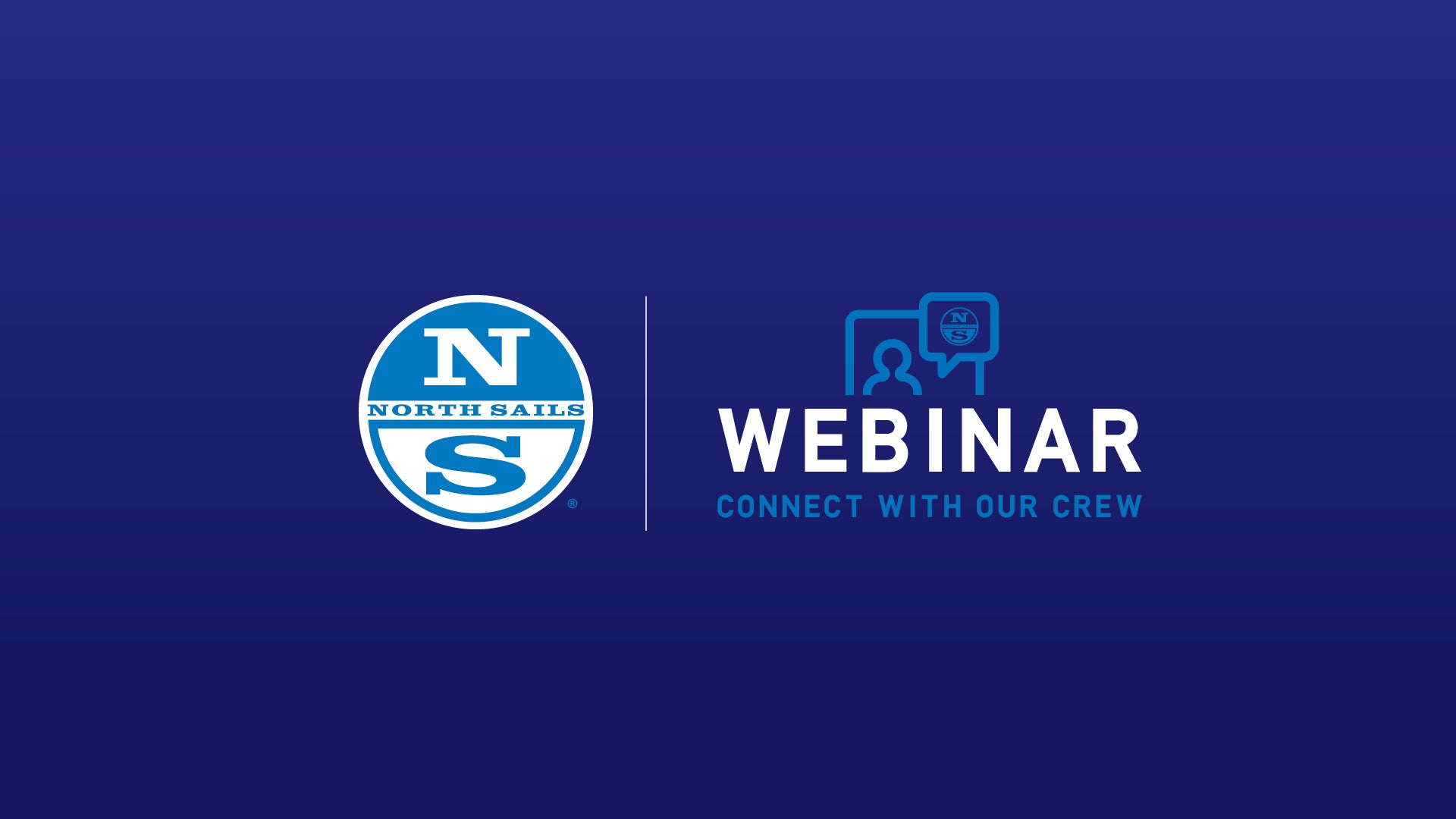
LET'S TALK 420 | SAIL TRIM [PORTUGUESE]
LET’S TALK 420
Sail Trim with Diogo Costa, Pedro Costa, Lollo de Felice and Hugo Rocha
Webinar presented in Portuguese featuring guest speakers and 420 Champions Diogo Costa and Pedro Costa moderated by North experts Lollo de Felice e Hugo Rocha.
READ MORE
READ MORE
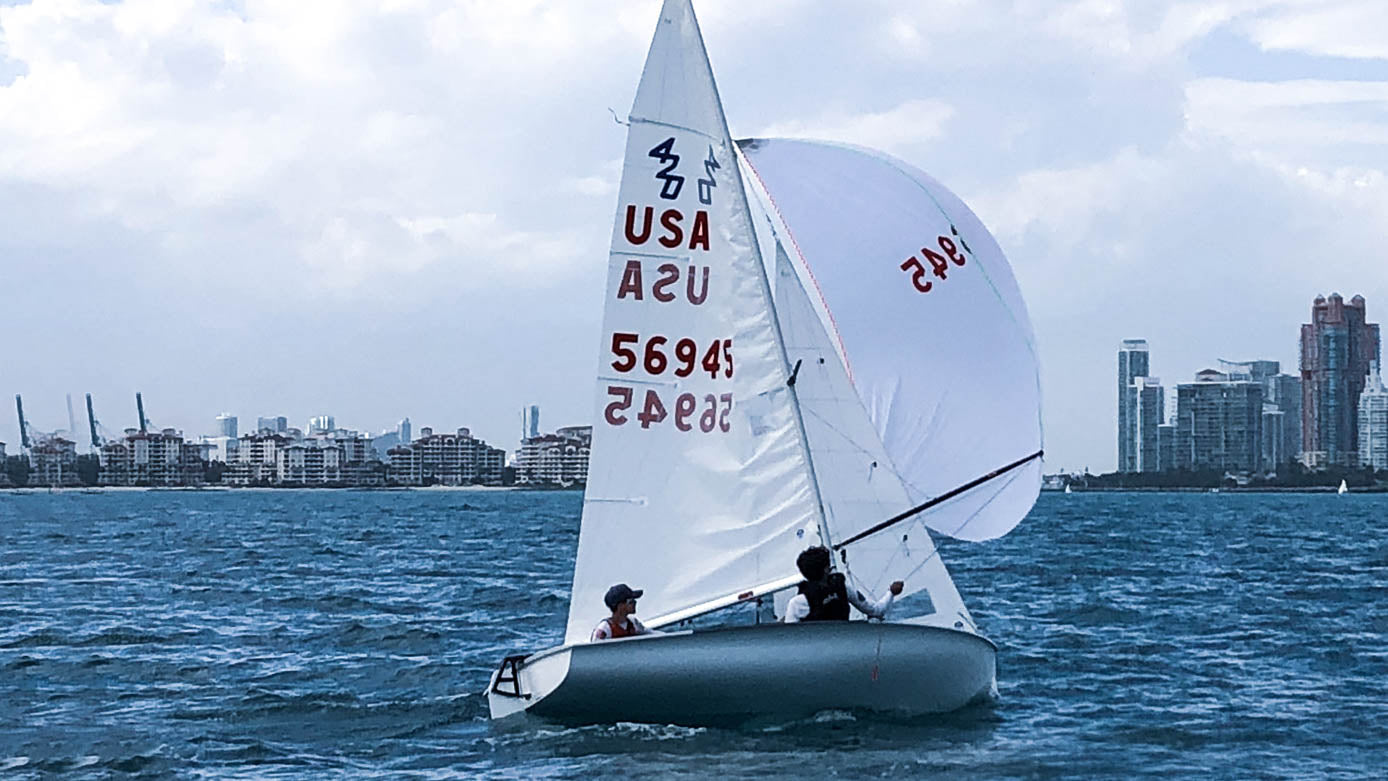
420 MIDWINTERS: COACH NOTES
420 MIDWINTERS: COACH NOTES
Key Tips To Up Your Game
35 teams from around the country gathered at the Miami Yacht Club for the 2020 International 420 Midwinter Championship. Out of the high caliber of talent, Justin & Mitchel Callahan prevailed with outstanding sailing and a convincing win at this event. North Sails powered boats fared very well, showing speed and versatility in a range of conditions, ultimately placing seven of the top ten boats in the overall results.
Here are some coach notes from North expert Tom Sitzmann:
Know your own boat
As much as we’d love to think that our hulls, spars, foils, sails, and individual tuning measurements are exact, the reality is that each boat, and all gear associated with it, is unique. With a tuning partner, experienced coach, or both, make sure you get out on the water before racing to check your rig settings and sail trim – no two boats are exactly alike! Use tuning guides as a starting point, experiment when able, but proof of concept is only validated on the water.
Spinnaker trim on the reach legs
There are LOTS of gains to be made on the “outer” reach and in the final sprint to the finish. Again, it is critical to know the design philosophy of your spinnaker and trim accordingly. Pole height, often set and forgotten about, can be a big difference-maker for an i420 on the wire reach. Experiment and improve!
Learn more about 420 sails.
Re-tuning for the lighter wind prediction on the final day.
Haul to the open-water sailing east of Key Biscayne
READ MORE
READ MORE
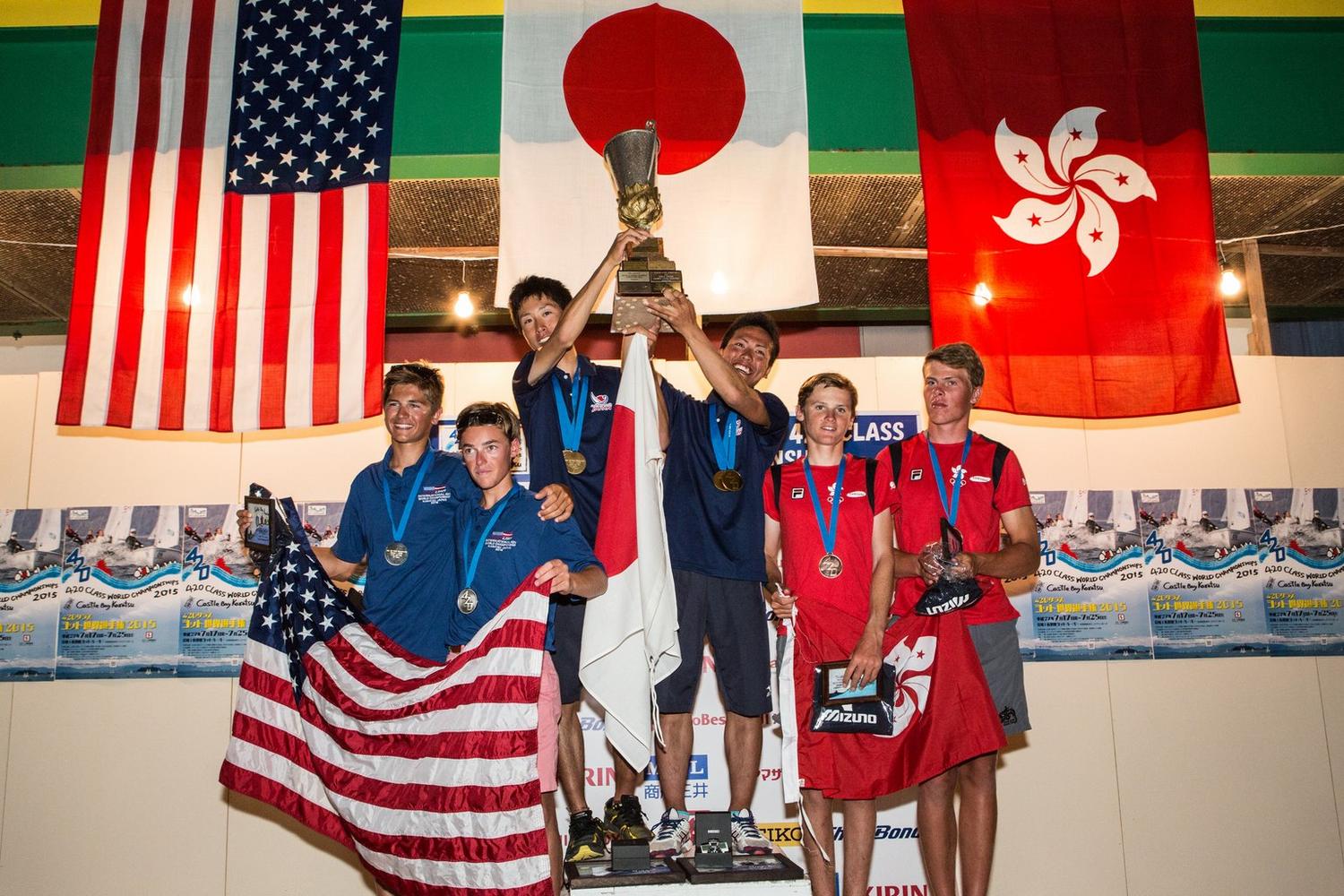
2015 I420 WORLDS: HOMETOWN WIN
North Sails-Powered Teams Win 420 Class Worlds in Japan
Congratulations to Daichi Takayama and his crew, Syota Nakano for winning the 420 Class World Championship in Castle Bay Karatsu, Japan. The duo, racing with a complete North Sails 420 inventory, sailed very well in a highly competitive regatta with 168 boats from 22 countries. “Congratulations to Daichi and Syota for a great win in their home waters,” said Kei Takakuwa, Sales Manager for North Sails One Design in Japan. “We are very proud of their accomplishment and look forward to following them on their journey to the 2016 Olympic Games,” Takakuwa said.
North Sails-powered boats also finished 3rd (Calum Gregor/Hugo Christensson / Hong Kong), 4th (Vasillios Gourgiotis/Epameinodas Orestis / Greece) and 5th (Hiroaki Kato/Takuma Yoshinaga / Japan) in the open class.
North Sails would also like to congratulate the top eight female teams, all powered by North Sails*, for taking top honors in their 60-boat division. Marta Garrido and Maria Jesus Davila from Spain took the gold medal without having to sail the last race. “The level of competition among the women’s class is incredible and we are very proud that teams using North Sails finished in the top eight places,” continued Takakuwa. “These sailors are incredible athletes and I am sure we will see many of them at the Olympic Games next summer,” he said.
Congratulations to the following North Sails-powered teams in the ladies division:
1. Marta Garrido/María Jesus Dávila (ESP)*
2. Charlotte Yven/Marine Riou (FRA)
3. Misaki Tanaka/Sena Takano (JPN)
4. Nia Jerwood/Lisa Smith (AUS)
5. Sarah Norbury/Mari Davies (GBR)
6. Marina Lefort/Lara Granier (FRA)
7. Mano Udagawa/Yuri Saito (JPN)
8. Theres Dahnke/Birte Winkel (GER)*
*-Majority North Sails inventory
The North Japan designed International 420 sails are available worldwide through the North loft network.
More information and photos visit the 420 Class Worlds Website
Photos: Jun Hirai
READ MORE
READ MORE